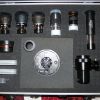-
Posts
157 -
Joined
-
Last visited
Content Type
Profiles
Forums
Gallery
Events
Blogs
Posts posted by bob1957
-
-
Good point Olly. The panel area decreases as the angle towards the vertical increases as the Sun passes overhead, unless as you say the panels can track the movement of the Sun for optimum area.
-
Good point Olly. The panel area decreases as the angle towards the vertical increases as the Sun passes overhead, unless as you say the panels can track the movement of the Sun for optimum area.
-
Ronnie,
a. First you will need to calculate the flux (watts/km2) which falls on the Earth's surface from the Sun. You have the Sun's luminosity as 4.0E33 erg/s which is equal to 4.0E26 Watts. Using the distance from the Sun to the Earth of about 1.5E8 km calculate the surface area of a sphere using this distance as the radius. Divide the power from the Sun by the surface area and this will give you the flux at the Earth's surface. You know you need 1 Gigawatt (1E10 Watts) output power from the solar array, but remember it's only 10% efficient so you need more power going into the array, i.e. 1E10 Watts. Now divide this required input power to the array by the flux falling onto it and it should give you the area of the array in square kilometres.
b. Here you can you use the small angle approximation which basically says that the angle (in radians) formed by a small object at a very large distance can be calculated by dividing the size of the object by it's distance (all in metres). So if you know the angle (in this case the angular resolution) you can rearrange it to find the distance in metres by dividing the size of the object (in metres) by the angle (in radians). But you will have to convert the angular resolution of 0.5 arcseconds into radians. If you are not familiar with this multiply the number of degrees by pi and divide by 180. Remember there are 60 minutes in a degree and 60 seconds in a minute so one degree equals 1/3,600 arcseconds.
c. For diffraction limited optics you will need to calculate the angular diffraction. For this you will need the diameter of the optics in this case the Keck which I believe is 10 metres diameter and also the wavelength of light which you can approximate to 500 nm (5E-7 metres). The angular diffraction is calculated by dividing the wavelength of light by the diameter of the optics and multiplying by 1.22. This gives you the angular diffraction in radians. You can then use the small angle approximation outlined in b. to work out the distance using the angular diffraction you have just calculated and the size of the object.
I hope all of the above helps.
Cheers, Bob
-
 1
1
-
-
Hi Gonzo, I like the idea of your remote pico observatory and found your progress very interesting. I have a small garden and would like an obsy but can't go for the usual roll off roof type or dome, so your design looks to be exactly what I'm looking for, although slightly bigger for a C8 SCT mounted on a CG5-GT. Cheers, Bob
-
Hmmm, not quite sure why the image has come out so small

-
Here's mine (another from Maplins)


Bob
-
Over the past month I placed three orders with FLO, for tube rings, dovetail plates, extension tubes, eyepiece and upgraded saddle for my CG5-GT mount. Ordering online was straightforward by creating an account, with FLO acknowledging by email immediately after I placed the order and all items in stock were delivered in two working days from date of order. When the items were dispatched I was notified by email that one item was out of stock and on back order. This item was dispatched the following day.
I was looking to obtain a smaller, lighter compact scope compared with my 10" Newtonian and FLO's prompt service (and price) was a big factor in me deciding to order from them a Celestron C8 XLT OTA. SteveB at FLO was a great help. I placed my order online at 2pm on a Friday and SteveB had the scope with FedEx by 4pm the same day. I could have waited for FedEx to deliver on Monday, but I live out in the sticks and sometimes couriers have a problem finding us (plus I couldn't wait until Monday), so I collected the OTA from FedEx's depot on Saturday morning.
All queries were dealt with promptly using FLO's messaging system which seems to be the best way to contact them.
All in all I have been very pleased with FLO's service and would have no hesitation in ordering from them again.
Bob
-
 1
1
-
-
So has anyone used this successfully with a celestron nexstar based setup?
Similar comment - has anybody been successful with the CG5-GT mount?
Thanks, Bob









Need help with three questions
in Physics, Space Science and Theories
Posted
Seems I've developed a stutter!